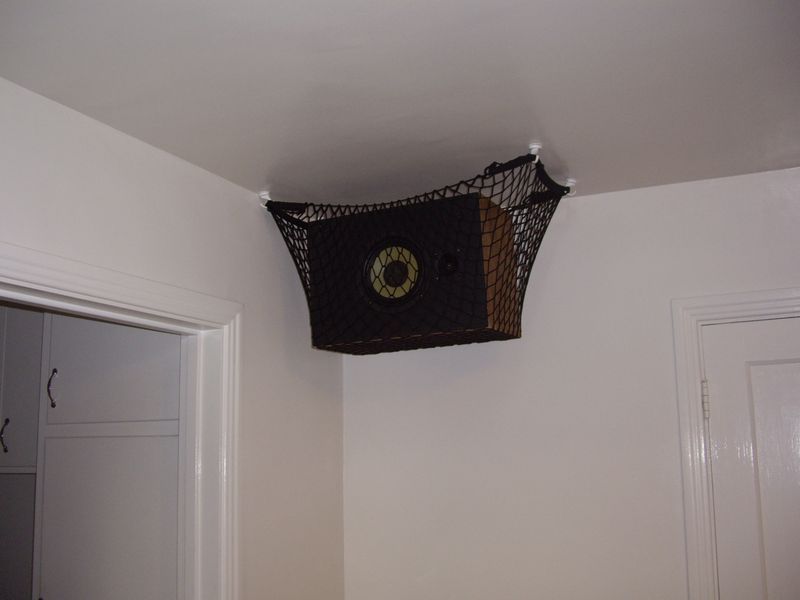Creating an immersive audio experience in your home or commercial space often requires more than just high-quality speakers. The placement and mounting of these speakers can significantly impact sound quality and room aesthetics. One popular solution is to hang speakers from the ceiling. This method can enhance sound distribution, save floor space, and provide a clean, modern look. In this comprehensive guide, we will explore the steps, tools, and tips for hanging speakers from the ceiling effectively.

Why Hang Speakers From the Ceiling?
Benefits of Ceiling-Mounted Speakers
- Improved Sound Distribution: Hanging speakers from the ceiling can provide better sound dispersion, ensuring that audio is evenly distributed throughout the room.
- Space Saving: Ceiling-mounted speakers free up floor and wall space, making the room appear less cluttered.
- Aesthetic Appeal: This setup can offer a sleek, modern look, with the speakers blending seamlessly into the ceiling.
- Safety: Elevated speakers reduce the risk of damage from accidental bumps and keep cords out of the way, minimizing tripping hazards.
Planning Your Setup
Assessing Your Space
Before starting, it’s crucial to assess your room’s layout and acoustics. Consider the following factors:
- Room Size and Shape: Larger rooms may require more speakers or higher-powered units for adequate coverage.
- Ceiling Height: Ensure your ceiling is high enough to accommodate hanging speakers without interfering with movement or sightlines.
- Acoustic Properties: Hard surfaces reflect sound, while soft surfaces absorb it. Balance these elements to optimize audio quality.
Choosing the Right Speakers
Not all speakers are suitable for ceiling mounting. Look for models designed for this purpose, often referred to as in-ceiling or ceiling-mounted speakers. Key features to consider include:
- Weight: Ensure the ceiling can support the speaker’s weight.
- Mounting Hardware: Check if the speakers come with brackets or if you need to purchase them separately.
- Wiring Compatibility: Ensure the speakers are compatible with your existing audio system and wiring setup.
Tools and Materials Needed
To hang speakers from the ceiling, you will need the following tools and materials:
- Speakers and Mounting Brackets: Designed for ceiling installation.
- Screwdriver: To secure brackets and screws.
- Drill and Bits: For creating holes in the ceiling.
- Stud Finder: To locate ceiling joists for secure mounting.
- Measuring Tape: For precise placement.
- Level: To ensure the speakers are mounted evenly.
- Speaker Wire: Sufficient length to connect the speakers to your audio source.
- Wire Strippers: For preparing the speaker wire ends.
- Ladder: To safely reach the ceiling.
Step-by-Step Guide to Hanging Speakers From the Ceiling
Step 1: Plan Speaker Placement
Decide on the optimal locations for your speakers. Typically, speakers should be evenly spaced and positioned to cover the entire listening area. Avoid placing them too close to walls or corners to prevent sound distortion.
Step 2: Locate Ceiling Joists
Use a stud finder to locate the ceiling joists. These provide the necessary support for the weight of the speakers. Mark the joist locations with a pencil.
Step 3: Install Mounting Brackets
Align the mounting brackets with the ceiling joists and mark the screw holes. Drill pilot holes and attach the brackets securely using screws. Ensure they are level and firmly attached to support the speakers’ weight.
Step 4: Run Speaker Wires
Run the speaker wires from your audio source to the speaker locations. Conceal the wires within the ceiling or along the edges to maintain a clean look. Strip the wire ends using wire strippers to prepare them for connection.
Step 5: Connect and Mount the Speakers
Connect the speaker wires to the speakers according to the manufacturer’s instructions. Attach the speakers to the mounting brackets, ensuring they are securely fastened. Double-check the connections and placement.
Step 6: Test the System
Once the speakers are installed, test the system to ensure they are working correctly. Adjust the positioning if necessary to optimize sound quality. Check for any loose connections or mounting issues.
Tips for Optimal Sound Quality
Positioning
- Central Placement: Position speakers centrally relative to the listening area for balanced sound distribution.
- Height Considerations: Avoid mounting speakers too high or too low. Ideally, they should be at an angle that directs sound towards the listening area.
- Avoid Obstacles: Ensure there are no obstacles that could block or reflect sound waves, such as large furniture or fixtures.
Wiring and Connectivity
- High-Quality Wires: Use high-quality speaker wires to ensure clear audio signals.
- Secure Connections: Ensure all wire connections are secure and free of corrosion or damage.
Calibration
- Audio Calibration: Use an audio calibration tool or software to fine-tune your sound system for the best audio experience.
- Speaker Angles: Adjust the angles of the speakers to optimize sound coverage and minimize dead spots.
Maintenance and Safety Tips
Regular Inspections
Periodically inspect the speakers and mounting brackets to ensure they remain secure. Tighten any loose screws and check for signs of wear or damage.
Dust and Clean
Dust the speakers regularly to prevent buildup that can affect sound quality. Use a soft cloth or a vacuum with a brush attachment to clean them without causing damage.
Safety Precautions
When performing maintenance or adjustments, always turn off the audio system and use a stable ladder. Ensure all wires are properly insulated and secured to prevent electrical hazards.
Read too: Striped Schoolhouse Ceiling Light Fixtures: Unveiling the Timeless Charm
Conclusion
Hanging speakers from the ceiling is an excellent way to enhance your audio experience while maintaining a clean and modern aesthetic. By carefully planning your setup, choosing the right equipment, and following proper installation procedures, you can achieve optimal sound quality and functionality. Regular maintenance and adherence to safety precautions will ensure your ceiling-mounted speakers continue to perform well for years to come.